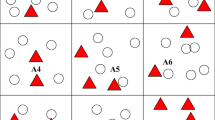Abstract
Mobile crowd sensing, as a new paradigm, means that mobile users equipped with smart devices to solve large-scale mobile sensing tasks through wireless communication. Data transmission schemes with opportunistic network in mobile crowd sensing have attracted widespread attention recently, which attempt to reach high delivery and low consumption. However, most transmission schemes resort to users’ trajectory and connection history that are dynamic and difficult to calculate, causing it so hard to establish stable connection channel. For achieving energy-efficient transmission, an energy-efficient data transmission protocol is proposed in this paper, which deploys static nodes to assist in information transmission based on Archimedes curve. Meanwhile, the significant performance of the proposed protocol is demonstrated through extensive simulations based on the ONE platform.









Similar content being viewed by others
References
Xiao F, Yang X, Yang M, Sun L, Wang R, Yang P (2016) Surface coverage algorithm in directional sensor networks for 3D complex terrains. Tsinghua Sci Technol 21(4):397–406
Guo B., Yu Z., Zhou X. (2014) From participatory Sensing to Mobile Crowd Sensing. 2014 I.E. International Conference on Pervasive Computing (PERCOM 2014), Budapest, Hungary, pp 593–598
Ganti RK, Ye F, Lei H (2011) Mobile crowd sensing: current state and future challenges. IEEE Commun Mag 49(11):32–39
Surowiecki J (2005) The wisdom of crowds: why the many are smarter than the few. ABACUS, London
Cardone G, Foschini L, Bellavista P, Corradi A, Borcea C, Talasila M, Curtmola R (2013) Fostering participation in smart cities: a geo-social crowd sensing platform. IEEE Commun Mag 51(6):112–119
Hu X, Chu T, Chan H, Leung V (2013) Vita: A crowd sensing oriented mobile cyber-physical system. IEEE Transactions on Emerging Topics in Computing 1(1):148–165
Sun J (2013) An incentive scheme based on heterogeneous belief values for crowd sensing in mobile social networks. Global Communication Conference (GLOBECOM) 2013, Atlanta, GA, pp 1717–1722
Jin H, Su L, Chen D, Klara N, Xu, J (2015) Quality of information aware Incentive Mechanism for Mobile Crowd Sensing Systems. International Symposium on Mobile Ad Hoc Networking and Computing (MobiHoc) 2015, Hangzhou, China, pp 167–176
Zhao D, Li X, Ma H (2014) How to crowdsource tasks truthfully without sacrificing utility: Online incentive mechanisms with budget constraint. The 33rd Annual IEEE International Conference on Computer Communications (INFOCOM 2014), Toronto, Canada, pp 1213–1221
Guo B, Yu Z, Zhang D, Zhou X (2013) MemPhone: From Personal Memory Aid to Community Memory Sharing using Mobile Tagging. Pervasive Computing and Communications Workshops (PERCOM WORKSHOP 2013), San Diego, GA, pp 332–335
Rana, R (2010) Ear-Phone: An End-to-End Participatory Urban Noise Mapping. The 9th ACM/IEEE International Conference on Information Processing in Sensor Networks (ISPN 2010), New York, USA, pp 105–116
Eisenman SB, et al (2007) The BikeNet Mobile Sensing System for Cyclist Experience Mapping. Proceeding of the 5th international conference on Embedded networked sensor systems (SenSys 2007), Sydney, Australia, pp 87–101
Coric, V, Gruteser, M (2013) Crowdsensing maps of on-street parking spaces. Proceeding of the 2013 I.E. international conference on distributed computing in sensor systems, Washington, USA, pp 115–122
Zhang L, Yu B, Pan J (2014) GeoMob: A Mobility-aware Geocast Scheme in Metropolitans via Taxicabs and Buses. The 33rd Annual IEEE International Conference on Computer Communications (INFOCOM 2014), Toronto, Canada, pp 1779–1787
Seth C, Firas K, Adrien T, et al. (2010) Predicting protein structures with a multiplayer online game. Nature 466(7307):756–760
Pelusi L, Passarella A, Conti M (2006) Opportunistic networking: data forwarding in disconnected mobile ad hoc networks. IEEE Commun Mag 44(11):134–141
Guo B., Zhang D., Yu Z., Zhou X. (2012) Hybrid SN: Interlinking Opportunistic and Online Communities to Augment Information Dissemination. The 9th IEEE International Conference on Ubiquitous Intelligence and Computing (UIC 2012), Fukuoka, pp 188–195
Zhang H, Cheng P, Shi L, Chen J (2016) Optimal DoS attack scheduling in wireless networked control system. IEEE Transactions on Control System Technology 24(3):843–852
Chen J, Xu W, He S, Sun Y, Thulasiramanz P, Shen X (2010) Utility-based Asynchro-nous flow control algorithm for wireless sensor networks. IEEE Journal on Selected Areas in Communications 28(7):1116–1126
Meng W, Yang Q, Sun Y (2016) Guaranteed performance control of DFIG variable-speed wind turbines. IEEE Transactions on Control System Technology. doi:10.1109/TCST.2016. 2524531
Xiao F, Xie X, Jiang Z, Sun L, Wang R (2016) Utility-aware data transmission scheme for delay tolerant networks. Peer-to Peer Networking and Applications 9(5):936–944
Ding S, He X, Wang J, Dai W, Wang X (2015) Static Node Center Hexagonal Deployment in Hybrid Crowd Sensing. IEEE International Conference on High Performance Computing and Communications (HPCC 2015), New York, USA, pp 515–520
Zhao D, Ma H, Liu L (2014) Energy-efficient opportunistic coverage for people-centric urban sensing. Wirel Netw 20(6):1461–1476
Ding Y, Xiao L (2010) SADV: static–node-assisted adaptive data dissemination in vehicular networks. IEEE Trans Veh Technol 59(5):2445–2455
He S, Chen J, Li X, Shen X, Sun Y (2014) Mobility and intruder prior information improving the barrier coverage of sparse sensor networks. IEEE Trans Mob Comput 13(6):1268–1282
Zhang Y, He S, Chen J (2015) Data gathering optimization by dynamic sensing and routing in rechargeable sensor networks. IEEE/ACM Transactions on Networking 24(3):1632–1646
Acknowledgments
This work is supported by the National Science Foundation of China under grants (No.61373137, 61373017, 61572261), Major Program of Jiangsu Higher Education Institutions under grant No.14KJA520002 and Six Industries Talent Peaks Plan of Jiangsu under grant No.2013-DZXX-014.
Author information
Authors and Affiliations
Corresponding author
Rights and permissions
About this article
Cite this article
Xiao, F., Jiang, Z., Xie, X. et al. An energy-efficient data transmission protocol for mobile crowd sensing. Peer-to-Peer Netw. Appl. 10, 510–518 (2017). https://doi.org/10.1007/s12083-016-0497-5
Received:
Accepted:
Published:
Issue Date:
DOI: https://doi.org/10.1007/s12083-016-0497-5




